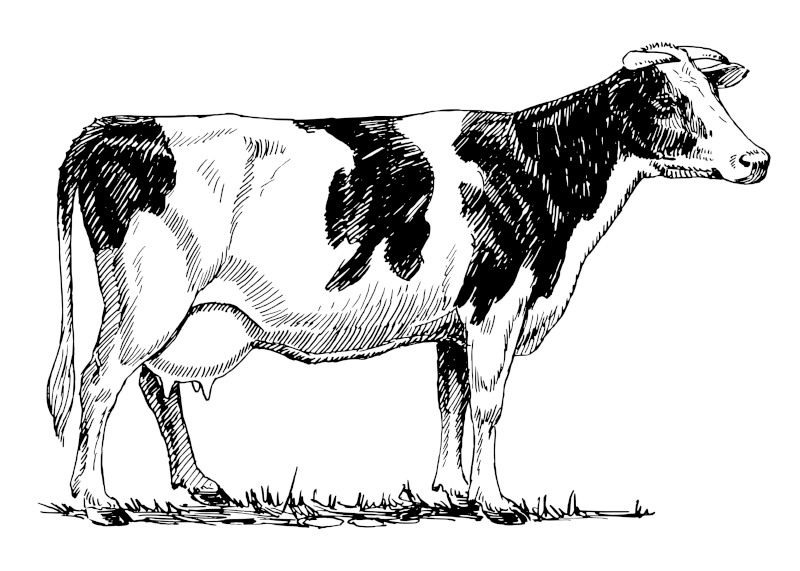Discover some cow drawings and paintings in this extensive article, and also discover tips and techniques on how to create your own cow art at home.
Introduction to Cow Drawings
Cows have always had a strong connection to humanity, helping to keep us healthy, whilst also decorating our landscapes and green, rolling fields. The more romantic landscape paintings will typically have a herd of cows dotted about the scene, with small dabs or squares of white paint being enough for us to identify these animals. But for how long have cows featured in art? This article will outline the use of cows in art, and also address technical issues to consider which are specific to this animal.
You will notice from the list below that cows have been featured in a huge variety of ways over the centuries, representing their different roles in society as well as different symbolic values that have been appended to these creatures in different cultures and civilizations. The same can be said for other related themes such as fish, birds and butterflies, providing a survey of changing artists tastes across thousands of years.
List of Cow Drawings and Paintings
We have included short summaries of artist careers next to each image, in order to place each artwork within their overall oeuvre. Most of the artworks relate to illustrations, with the original pencil or charcoal lines still visible. This should help you to understand how to draw cows yourself, and it is advisable to start off with some easy sketches before trying anything too complicated. Some will trace elements from these images in order to get an understanding of the curves and lines associated with this animal.
Some of the more complex oil paintings can also excite us, and provide inspiration to more advanced artists. Most amateurs would intially start with simple line sketching before moving on to other mediums such as acrylics, oils and watercolors. We have included a selection of all of them in this comprehensive gallery list below, with some famous artists also featuring within that.
Holstein cow png, vintage animal clipart
This charming illustration of a Holstein cow is a good place to start for those looking to learn how to draw a quick cow, relatively easily. This vintage sketch features plenty of detail, but you might prefer just to start with an outline, and then start to add the key parts of the animal as you go. The patches of black are typical of what we consider cows to look like, or at least in some regions of the world. Cows are often painted in the distance as dabs of white paint, and this is due to breeds such as these. The side profile of this drawing allows us to see all of the main attributes of this animal.
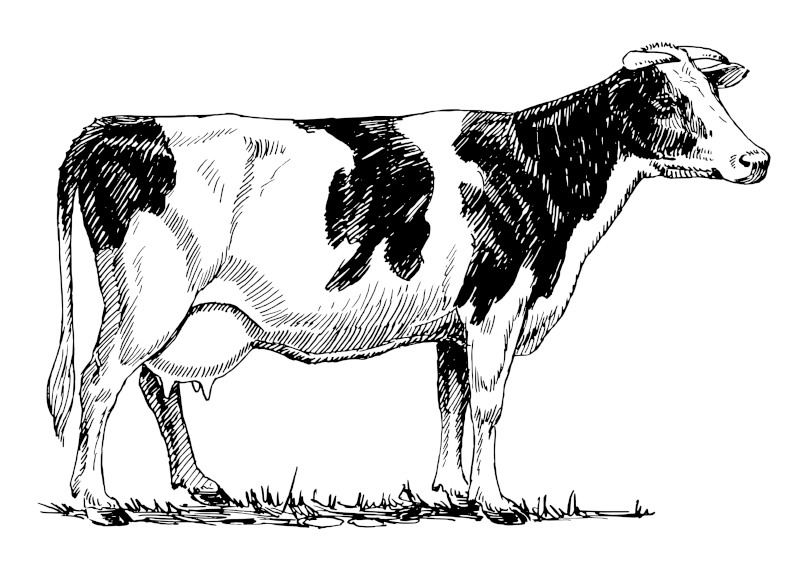 Holstein cow png, vintage animal clipart (image provided by rawpixel under a copyright-free license)
Holstein cow png, vintage animal clipart (image provided by rawpixel under a copyright-free license)
Beef diagram png sticker, cow hand drawn illustration
This diagram features a cow in side profile, but with its sections of beef drawn out across the side of its body. This type of informative art can sometimes be found in butchers, as a means to educating customers about where each cut comes from. In the modern world, people are paying more attention to the sources of their food, its preparation and much more as we attempt to be more ethically sound in our choices. Some would probably be unhappy to see a cow portrayed in this manner, almost akin to a map of food.
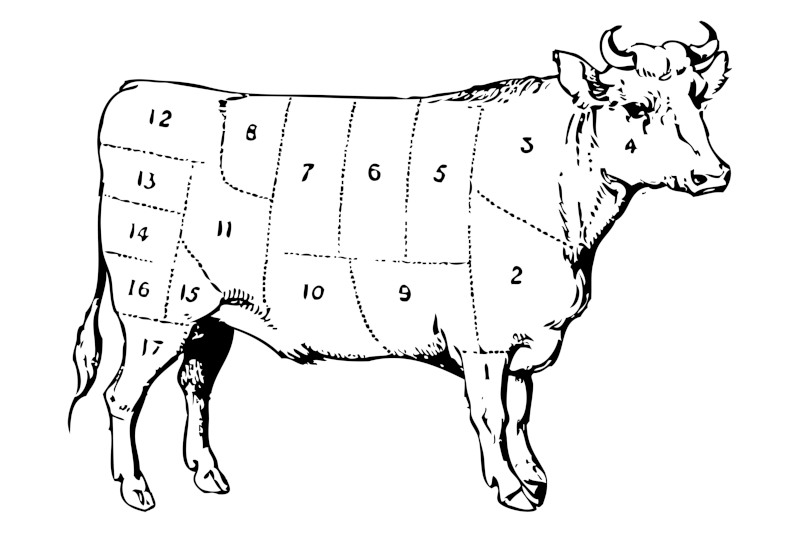 Beef diagram png sticker, cow hand drawn illustration (image provided by rawpixel under a copyright-free license)
Beef diagram png sticker, cow hand drawn illustration (image provided by rawpixel under a copyright-free license)
Cow png sticker vintage farm animal illustration
This side profile of a cow features an animal with a relatively slim build, relaxing in pasture land with a few small features left in the background. The muscular balance of the creature is beautifully delivered and clearly the artist in this piece would have been very familiar with the structure of the cow, and perhaps studied it for an extended period before being able to work as accurately as this. Lines are varied in proximity to each other to create the illusion of shadowing in the lower part of the cow.
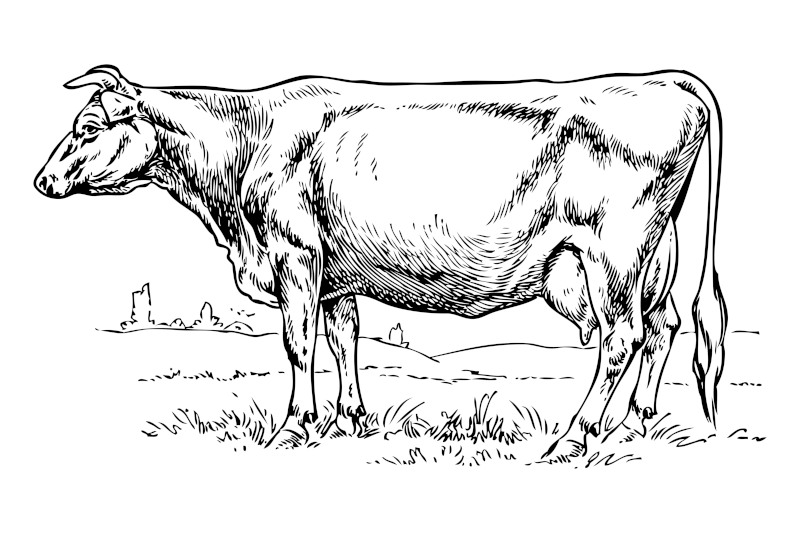 Cow png sticker vintage farm animal illustration (image provided by rawpixel under a copyright-free license)
Cow png sticker vintage farm animal illustration (image provided by rawpixel under a copyright-free license)
Cattle and dairy farming
This vintage drawing features considerable detail, as well as color, to produce a sellable artwork that could also potentially be used in scientific literature, where different breeds of cow are presented to the reader. The ribs and horns are particularly memorable in this piece.
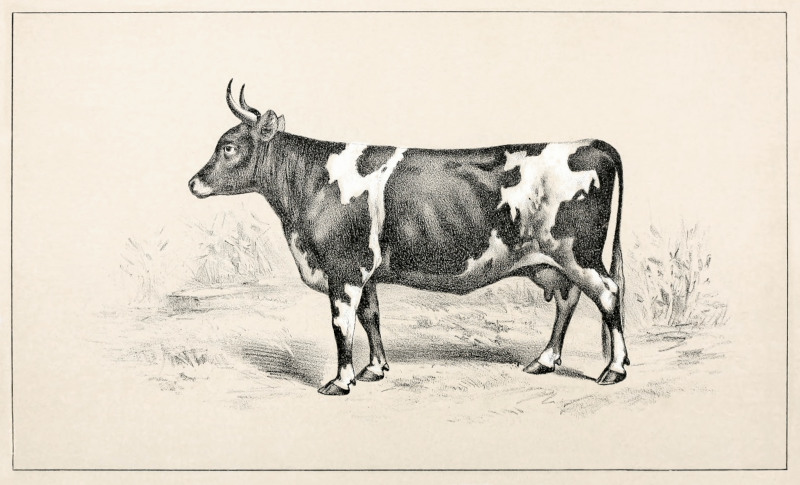 Cattle and dairy farming (image provided by rawpixel under a copyright-free license)
Cattle and dairy farming (image provided by rawpixel under a copyright-free license)
Cow png sticker, animal line art
This modern depiction reduces a cow head to just a few illustrative lines, making use of negative space and also our existing knowledge of the creature to fill in the blanks in our own minds. This drawing could easily be produced as digital art, and potentially re-purposed in a number of other formats, using the svg technology. This style of art is popular today with younger audiences and also translates perfectly into poster art, with very clear, impactful imagery.
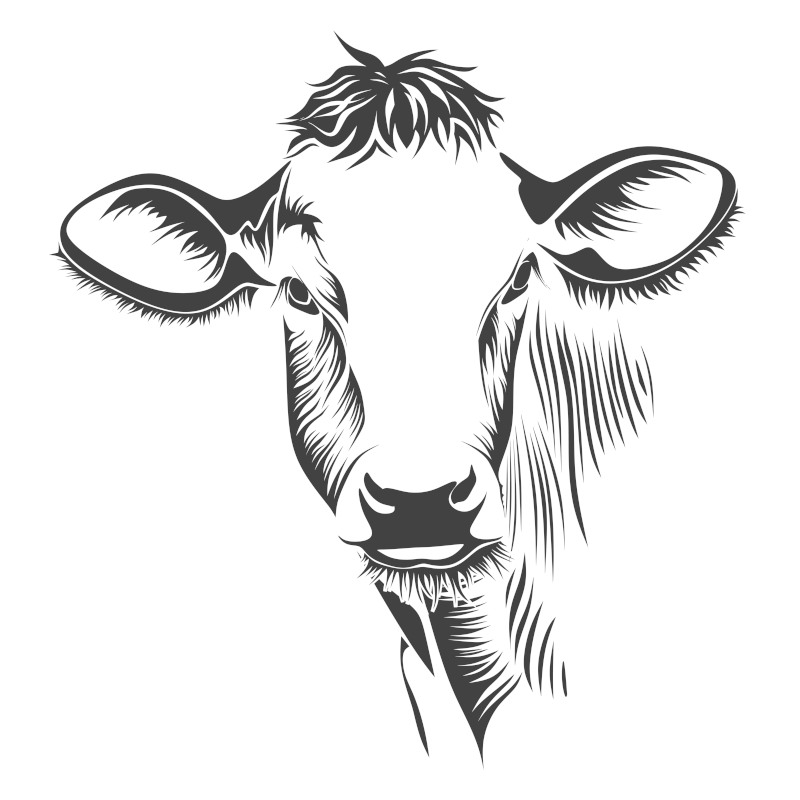 Cow png sticker, animal line art (image provided by rawpixel under a copyright-free license)
Cow png sticker, animal line art (image provided by rawpixel under a copyright-free license)
Two bull heads by Jean Bernard
Jean Bernard was a highly accomplished draughtsman who covered many different animals across his career, including the bulls featured here. He worked to achieve a high level of accuracy and was able to do so by honing his technical work alongside a strong use of observation to spot each intricate difference, from one breed or animal to the next. He remains one of the most famous animal artists of all time, and much of his work remains in national galleries in the Netherlands and other parts of Europe. The detail in this drawing is extraordinary, and it would have taken considerable amounts of time to complete this piece, even though he had covered bulls and cows before.
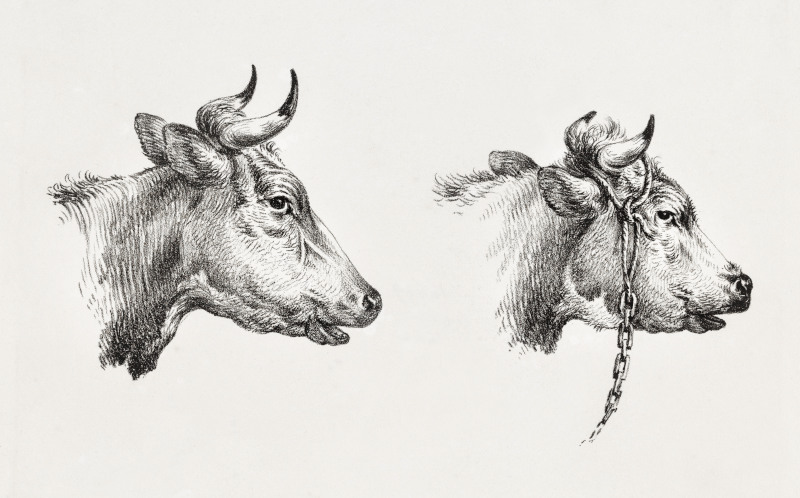 Two bull heads by Jean Bernard (image provided by rawpixel under a copyright-free license)
Two bull heads by Jean Bernard (image provided by rawpixel under a copyright-free license)
Lying cow by Jean Bernard
The artist focuses on a more real world depiction of a cow in this piece, as it lies in a field. He choses lighter touches of charcoal or pencil here, which helps to give the illusion of light flooding in from the top of the artwork.
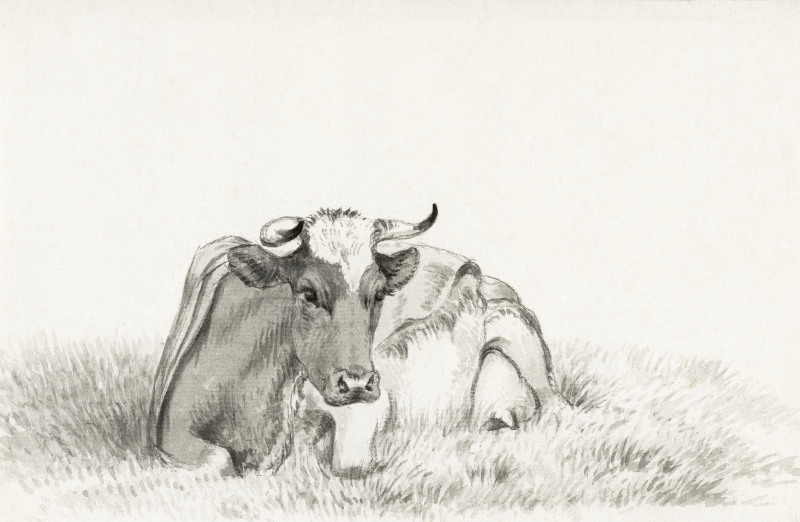 Lying cow by Jean Bernard (image provided by rawpixel under a copyright-free license)
Lying cow by Jean Bernard (image provided by rawpixel under a copyright-free license)
Guernsey cow png clipart, farm animal hand drawn illustration
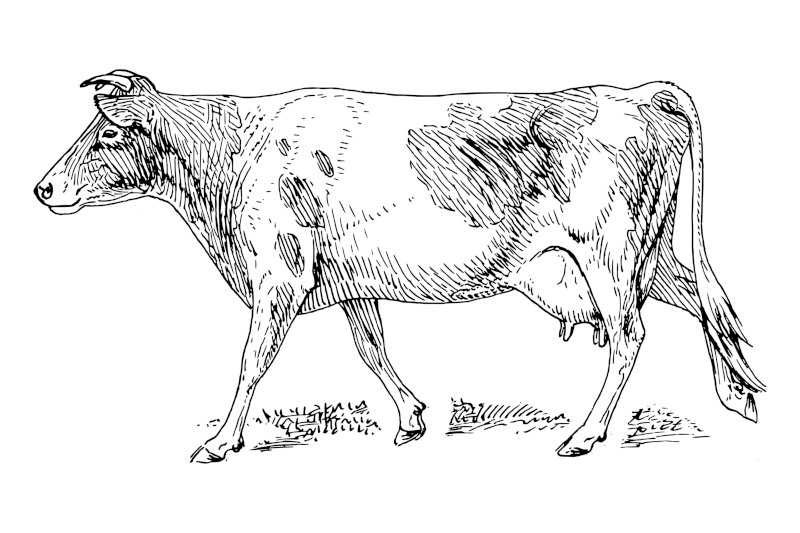 Guernsey cow png clipart, farm animal hand drawn illustration (image provided by rawpixel under a copyright-free license)
Guernsey cow png clipart, farm animal hand drawn illustration (image provided by rawpixel under a copyright-free license)
Vintage bull png, animal clipart, transparent background
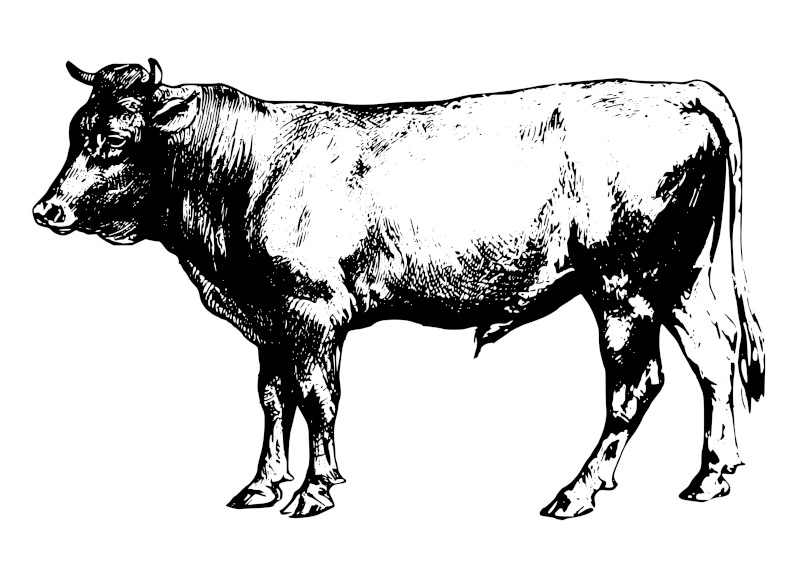 Vintage bull png, animal clipart, transparent background (image provided by rawpixel under a copyright-free license)
Vintage bull png, animal clipart, transparent background (image provided by rawpixel under a copyright-free license)
Five cows, looking out at the viewer, standing in a field with a house behind them
This is a traditional artwork, featuring black and white cows within a landscape setting. This artwork could have been created anywhere across northern Europe over the past few centuries, but the artist remains unknown. The style of the architecture in the distance might give a few clues, but the piece remains an excellent display of cow anatomy within a natural setting. The exporting of cow breeds has meant that one cannot assume a location based on the types of cows anymore, and this spread will likely continue in the new global world.
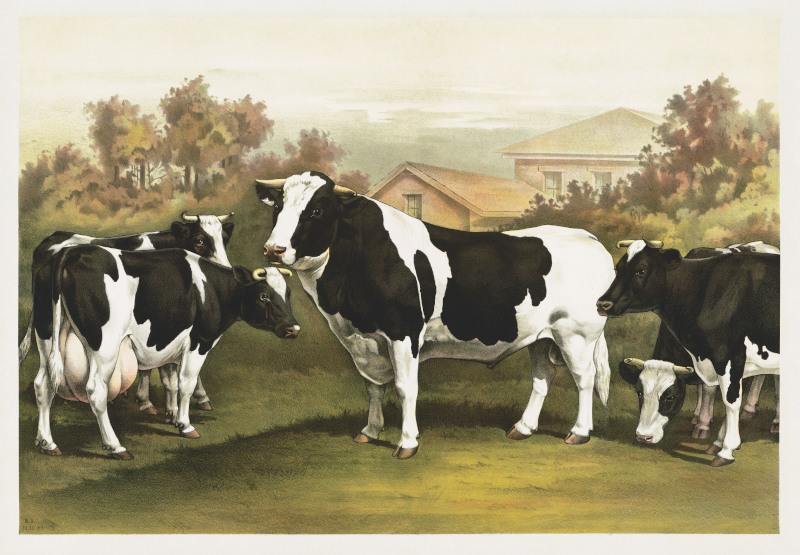 Five cows, looking out at the viewer, standing in a field with a house behind them (image provided by rawpixel under a copyright-free license)
Five cows, looking out at the viewer, standing in a field with a house behind them (image provided by rawpixel under a copyright-free license)
Head of a Cow or Ox by Samuel Colman
Samuel Colman was a talented artist and particularly skilled in his depictions of animals, with this piece featuring a study painting of a cow or ox. It was left un-developed around the main focal point, and perhaps this image was to be re-produced in a larger, more complex work. The quality of it means that some would be happy to purchase it for their own collections, with the level of detail and use of color being particularly impressive.
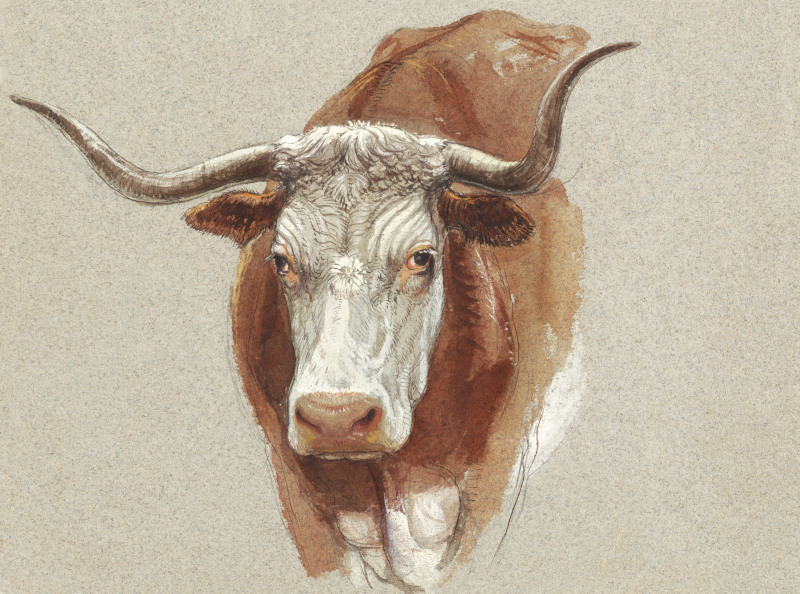 Head of a Cow or Ox by Samuel Colman (image provided by rawpixel under a copyright-free license)
Head of a Cow or Ox by Samuel Colman (image provided by rawpixel under a copyright-free license)
Cows in Spring by Ernst Ludwig Kirchner
Cows in Spring is a lesser known artwork from German Expressionist, Ernst Ludwig Kirchner. He loved to capture scenes in contrasting tones, and did not attempt to perfectly re-create life in a photo realistic manner. The postures of the cows in this piece are highly unusual, almost moving into the sphere of Surrealism, though without the bizarre combinations of elements together that the likes of Dali and Ernst would normally deliver. See also the abstract manner in which the landscape is completed in the far distance.
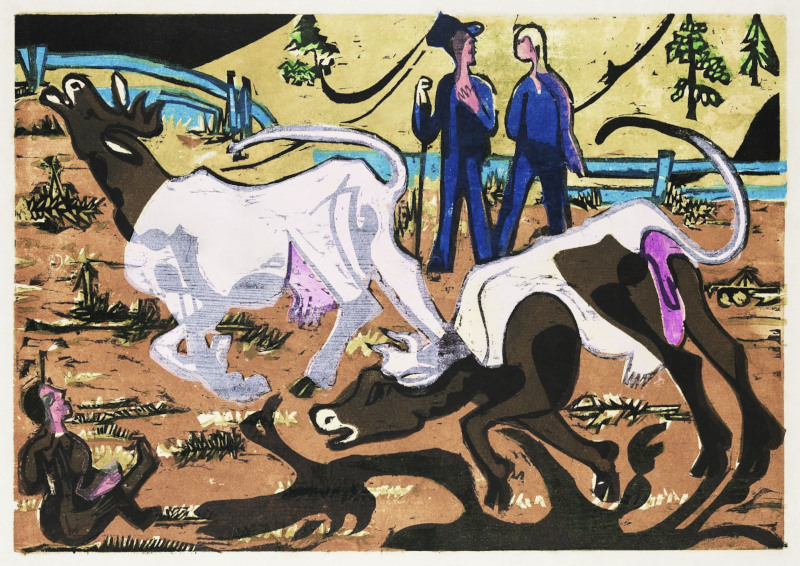 Cows in Spring by Ernst Ludwig Kirchner (image provided by rawpixel under a copyright-free license)
Cows in Spring by Ernst Ludwig Kirchner (image provided by rawpixel under a copyright-free license)
Oxen and Herdboys by Soga Shohaku
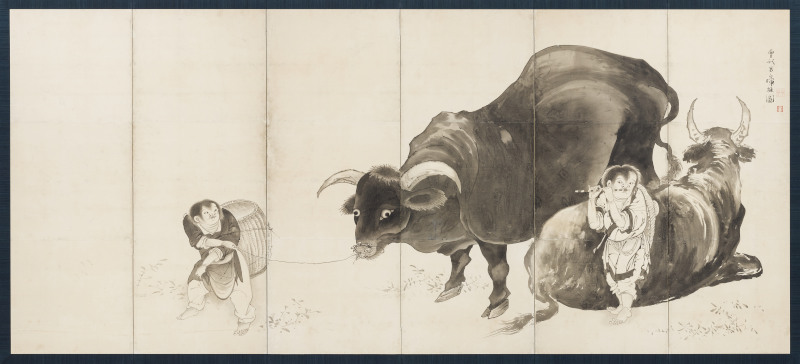 Oxen and Herdboys by Soga Shohaku (image provided by rawpixel under a copyright-free license)
Oxen and Herdboys by Soga Shohaku (image provided by rawpixel under a copyright-free license)
Skull of a cow by PC Skovgaard
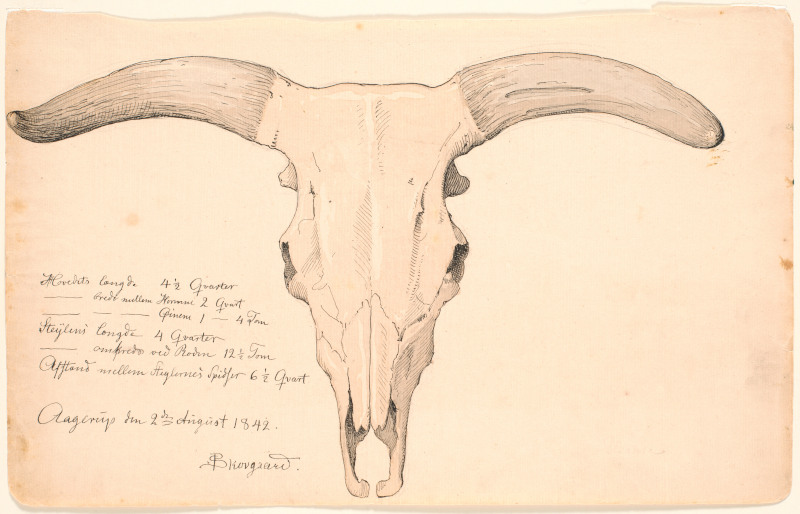 Skull of a cow by PC Skovgaard (image provided by rawpixel under a copyright-free license)
Skull of a cow by PC Skovgaard (image provided by rawpixel under a copyright-free license)
The Art of Capturing Bovine Beauty: An Introduction to Cow Drawings
Many find cows to be charming creatures, gentle, but physically imposing at the same time. They also play an important role in many of our lives, though this impact might not be immediately obvious to those living in built-up areas. Animals have inspired artists for centuries and cows have enjoyed a particular place in the hearts of many draughtsmen, oil painters and watercolorists. Whilst many of the tools would remain the same, regardless of the type of animal that you are covering, there are anatomical differences to consider for each one.
Cows have been one of the more accessible of animals to artists, and so there has been an improved accuracy as compared to more exotic choices that were often unavailable in large parts of the world. They have also been present in the great variety of European art movements, appearing in everything from the Romanticist era to the abstract methods of the 20th century.
From Cave Paintings to Canvas: A Brief History of Cow Depictions in Art
Cows appeared in cave paintings, marking the earliest examples of human art, and then played a role in Egyptian art, due to their role in agriculture. Many cultures also gave divine meaning to cows within their culture, ensuring a prominent role within local art, before European artists started to concentrate on real life. This brought new images of cows hard at work, alongside man, and Realism would become a popular art movement which reflected the lives of ordinary folk, often in rural areas.
Their depictions within rural settings was also found in the Romanticist era, but towards the 20th century we would find all manner of new inventive ways of capturing cows in art. Many would be entirely abstract, turning cow heads into re-usable patterns, or making use of bizarre and exciting palettes which bore no resemblance of reality. Today cows can be used to promote certain causes, such as meat in the diet, or alternatively to protect the animals themselves.
Tools and Techniques: Exploring Various Artistic Approaches to Drawing Cows
Many styles can be used to create cow art, depending on your own personal taste. Pen and ink was used by Japanese artists to give clear, concise works which relied on just a few, carefully crafted lines. Children tend to go for simple pencil sketches, also incorporating just a few lines to capture the key elements such as the cow head, legs and main torso. As artists progress, so they will be able to incorporate much greater detail and move towatds photo-realistic quality images.
There remains some who may be highly skilled, but prefer to revert back to basic tools, such as a pen or pencil. The likes of Picasso would rely on their genius to give us recognisable artworks with just a few lines, and also somehow create charming, cartoon-like pictures in the process. It is also possible to work initially with charcoal, before then adding other painted mediums over the top - watercolorists will often deliberately allow the original drawn lines to show through beneath the tones of color.
Anatomy and Proportions: Mastering the Essentials for Realistic Cow Drawings
There are several specific elements to consider when painting or drawing cows. You may start off with some loose outlines, followed by simple shapes to form the main elements of the cow. After this, you will need to consider elements such as eyes, ears, and muzzle, as well as shoulders, hips and and other limbs. The muscular balance can be touched on with a careful use of shading, which in illustration can be achieved through the variation of line intensity, as demonstrated by some of the artworks included in this article.
The udders and tail also require specific attention, and those unfamiliar with cows in art will struggle to complete these elements realistically without a good level of observation and practice. To go a step further, in order to really master this animal, regular practice is required and potentially an in-depth study of the creature through a variety of publications, just as others have done with horses, lions and more.
Embracing Creative Freedom: Abstract and Expressive Cow Artworks
As we moved into the 20th century, all of the achievements of the past were thrown out and anatomical accuracy was replaced by expression and abstraction. Some would use cow images as patterns for all manner of different purposes, whilst others reduced this complex animals into just a few lines or shapes. With landscape art having been established as a major genre since the time of Claude Lorrain, abstract artists would deliver cows in scenes with just a suggestion of form. Others would use digital software to create cows with different effects, and potentially alter the color palette to suit their own tastes.
Spotlight on Famous Cow Artists: Examining the Works and Contributions
Franz Marc's Yellow Cow is the most famous cow painting to date, though there have been a number of other artists who have used cows regularly within their work. Gustave Courbet would feature them regularly as part of his focus on Realism subjects which took in life in rural France. Rosa Bonheur was a specialist in animal art and achieved a mastery of this genre in oils, producing some truly breathtaking work. She remains one of the most famous female artists of all time, and was devoted to the countryside, understanding its way of life and wanting to capture its many qualities within her work.
Many other artists have included cows in experimental ways, but could not be considered specialists in this genre. Additionally, many illustrators have used cows in their work for children's stories, where animals are regularly re-purposed as specialist characters who are much loved by their young readers. There are many examples of this, dating back several decades, including the Peppa Pig series.
Step-by-Step Guide: Creating Your Own Stunning Cow Drawing
Start by loosely outlining the animal, before then constructing the torso and main limbs through the use of simple shapes. Once these are lightly drawn, you can start to tweak their detail into more specific elements and then start to work in more detail, such as with ears, eyes, the tail, etc. One can then, if you wish, work more detail into each element, adding shadowing, and textures for the muscles. Any additional content can then be added to set the scene, such as landscape elements like trees or clouds, and also elements of a farm environment, if appropriate.
Beyond Paper and Pencil: Cow Drawings in the Digital Age
Tsblets with digital pens are a great way of learning to draw. One can combine these tools with other opportunities found in the digital world, such as video tutorials. Software runs alongside these tools to enable quick corrections to your work, so that you can relax as you slowly build up an image over time. There is none of the panic found in other art forms when mistakes lead to significant time being spent on corrections. Digital devices are also kept on your person in any case, so you might be able to work at any time, with planning to do so especially. Compare this to a painter who drags an easel through the countryside, as they try to find precisely the right spot to work from.
Another positive is that working digitally, you do not need to worry about stock, where certain tools might run out, such as paper or pencils running low. With digital work, so long as batteries are recharged, then you should be good to go. You be also be able to translate these skills across to traditional tools at a later date, as digital drawing pens are deliberately based on traditional tools.
Showcasing Your Work: Exhibitions, Galleries, and Online Platforms
The online world offers cheap ways to exhibit your work, within minutes. Digital art can be stretched across different formats and products, making it worthwhile drawing in tablets or mobiles, so that your work can quickly be re-purposed, as opposed to trying to take photographs of work on paper. Alternatively, you might take advantage of local galleries and temporary displays which are often set up as a means to promoting local artists and giving opportunities to those who are still progressing their careers.
Another alternative can be to sell art yourself, either online or through a market stall. Many customers would love to purchase items directly from the artist themselves, who can inform them more about where each work was produced, and their inspiration for the content. The personal touch has been lost in retail in most cases, and so this method could work well for amateur artists with a strong body of work to sell.



